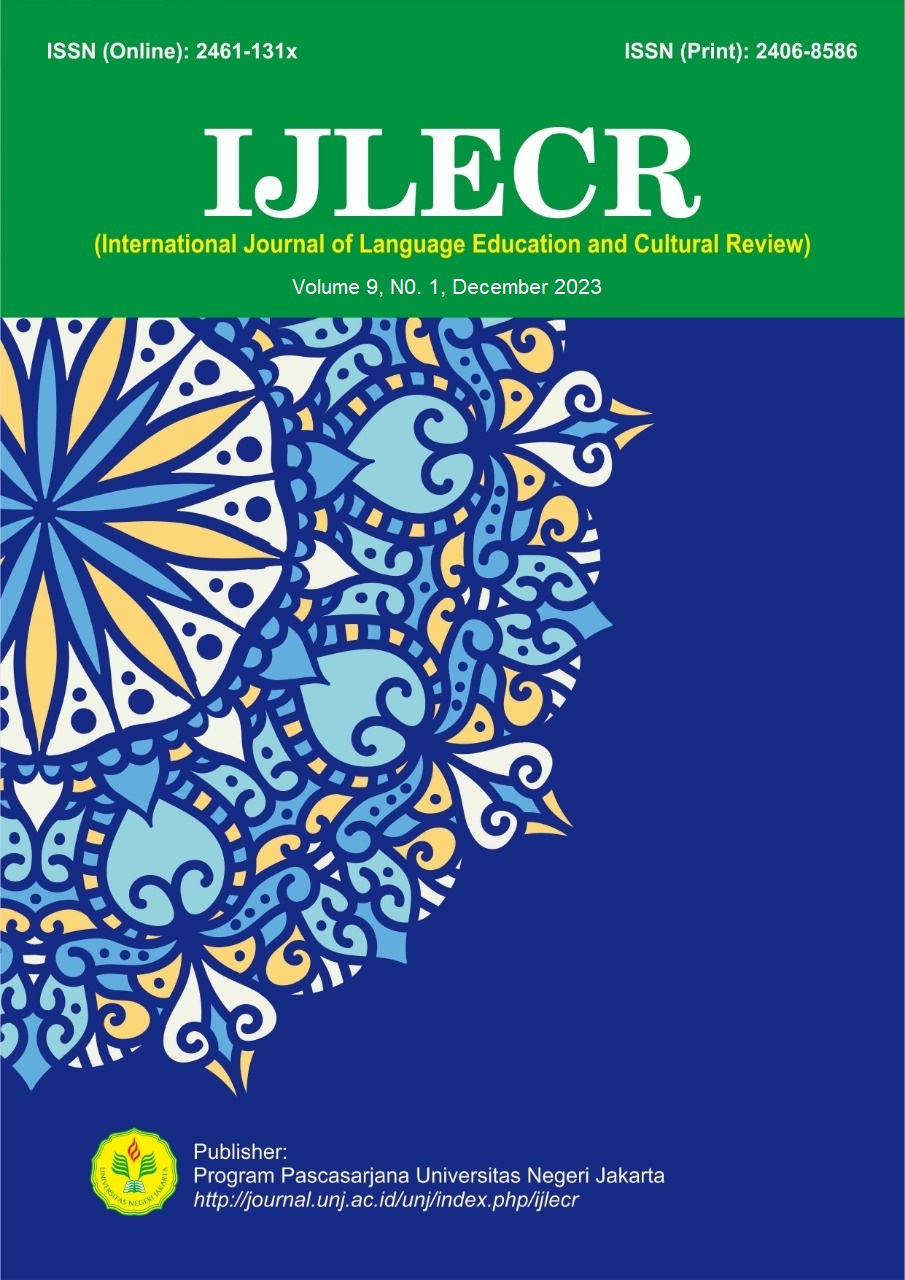Folklore-Based Virtual Reality as a Teaching Media in the Secondary School Viewed From its Implication and Multimodal Aspects
DOI:
https://doi.org/10.21009/ijlecr.v9i1.37646Keywords:
Folklore, Virtual Reality, Teaching Media, Secondary Schools, Multimodal Discourse AnalysisAbstract
This research article explores folklore-based virtual reality (VR) as a teaching medium in secondary schools, examining its effectiveness and impact on students' learning experiences. Taking advantage of virtual reality (VR) in education has several benefits, including enhancing students' learning experiences, facilitating more effective comprehension of concepts, and preparing students for the demands of an ever-evolving digital society. Drawing upon the multimodal discourse analysis framework, the study investigates how combining virtual reality technology and folklore narratives can enhance students' engagement, understanding, and retention of educational content. The findings highlight the potential of folklore-based VR as a powerful tool for immersive and interactive learning while shedding light on the multimodal aspects of the discourse generated through this medium. Educators can enhance the learning experience and foster a deeper understanding of cultural heritage and identity by integrating folklore-based virtual reality as a teaching medium. Moreover, Folklore-based virtual reality can encourage critical thinking skills as students navigate through complex narratives, make decisions, and solve problems within the virtual environment. Furthermore, exposure to diverse folklore stories and characters can promote empathy and understanding of different cultures, fostering a more inclusive and tolerant society. Integrating virtual reality (VR) technology into English education and literary resources presents promising prospects for students to actively interact with books through novel approaches, augmenting their understanding, language proficiency, and general admiration for literature. The research contributes to the growing field of educational technology by demonstrating the benefits of folklore-based VR as a pedagogical approach in secondary education.
References
Banda, D., & Morgan, W. J. (2013). Folklore is an instrument of education among the Chewa people of Zambia. International Review of Education, 59(2), 197–216. https://doi.org/10.1007/s11159-013-9353-5
Borman, R. I., Putra, Y. P., Fernando, Y., Kurniawan, D. E., Prasetyawan, P., & Ahmad, I. (2018). I am designing an Android-based Space Travel Application Trough Virtual Reality for Teaching Media. 2018 International Conference on Applied Engineering (ICAE), 1–5. https://doi.org/10.1109/INCAE.2018.8579394
Bunga, R. D., Rini, M. M., & Serlin, M. F. (2020). Peran cerita rakyat sebagai media pembelajaran bahasa Indonesia di kabupaten Ende. Retorika, 1(1), 65–77. http://e- journal.uniform.ac.id/index.php/RJPBSI/article/view/515
Draper, R. J. (2002). School mathematics reform, constructivism, and literacy: A case for literacy instruction in the reform-oriented math classroom. Journal of Adolescent & Adult Literacy, 45(6), 520-529.
Helsel S .(1992). Virtual reality and education. Educational Technology, 32(5), 38-42. https://www.jstor.org/stable/44425644
Lan, Y. J. (2020). Immersion, interaction and experience-oriented learning: Bringing virtual reality into FL learning. Language Learning & Technology, 24(1), 1–15. http://hdl.handle.net/10125/44704
Li, H. (2017). Design of multimedia teaching platform for Chinese folk art performance based on virtual reality technology. International Journal of Emerging Technologies in Learning, 12(9), 28. https://doi.org/10.3991/ijet.v12i09.7487
Loomis. J, Blascovich. J and Beall. A. (1999). Immersive virtual environment technology as a basic research tool in psychology. NCBI, 31, (4), 557-564. https://doi. org/10.3758/bf0320073
Markowitz, D. M., Laha, R., Perone, B. P., Pea, R. D., & Bailenson, J. N. (2018). Immersive virtual reality field trips facilitate learning about climate change—frontiers in Psychology, 9. Advanced online publication. https://doi.org/10.3389/fpsyg. 2018.02364
Maulana, Y. (2014). Cerita rakyat “Asal-Usul Pulau Halang”: Analisis fungsi Vladimir Propp. Madah, 5(1), 105–114. https://doi.org/10.26499/madah.v5i1.528
Michalopoulos, S., & Xue, M. M. (2021). Folklore. The Quarterly Journal of Economics, 136(4), 1993– 2046. https://doi.org/10.1093/qje/qjab003
Nopasari, D., Rozak, A., & Wiradinata, R. (2023). Digital Folklore Text Teaching Materials Loaded with Educative Values for SMP/MTs Students. International Journal of Secondary Education, 11(1), 11-17. doi: 10.11648/j.ijsedu.20231101.13
Peng, J. (2019). The roles of multimodal pedagogic effects and classroom environment in willingness to communicate in English. System 82, 161–173. doi 10.1016/j.system.2019.04.006
Peng, J., Zhang, L., and Chen, Y. (2017). The mediation of multimodal affordances on willingness to communicate in the English as a foreign language classroom. TESOL Q. 51, 302–331. doi: 10.1002/tesq.298
Purwadi. 2009. Folklore Jawa. Yogyakarta: Pura Pustaka.
Rahman, H., & Purwanto, W. E. (2021). Bentuk kearifan ekologis Papua dalam cerita rakyat Papua. Prosiding Seminar Bahasa dan Sastra Indonesia, 5(1), 318–325. https://doi.org/10.22219/.v5i1.4912
Selena Chan .(2013). Using videos and multimodal discourse analysis to study how students learn a trade, International Journal of Training Research, 11(1), 69-78, DOI: 10.5172/ijtr.2013.11.1.69
Shirer, M., Torchia, M. (2017, February 27). Worldwide spending on augmented and virtual reality will reach $13.9 billion in 2017. Businesswire. Retrieved from https://www.businesswire.com/news/home/20170227005097/en/Worldwide-Spending-AugmentedVirtual-Reality-Forecast-Reach.
Sholihin, M., Sari, R. C., Yuniarti, N., & Ilyana, S. (2020). A new way of teaching business ethics: The evaluation of virtual reality-based learning media. The International Journal of Management Education, 18(3), 100428–100428. https://doi.org/10.1016/j.ijme.2020.100428
Tilovberdiyevich, X., A. (2023). Virtual Reality in Education (On the Example of Applications). Journal of Pedagogical Inventions and Practices, 16(1), 29-31.
van Ginkel, S., Gulikers, J., Biemans, H., Noroozi, O., Roozen, M., Bos, T., van Tilborg, R., van Halteren, M., & Mulder, M. (2019). Fostering oral presentation competence through a virtual reality-based task for delivering feedback. Computers & Education, 134, 78–97. https://doi.org/10.1016/j.compedu.2019.02.006
Weller, M. (2007). Virtual learning environments: Using, choosing, and developing your VLE. London: Routledge.
Wickens C. D. (1992). Virtual reality and education. Proceedings IEEE International Conference on Systems, Man, and Cybernetics. – IEEE, 1992. – page. 842-847.
Yeh, H. C., Tseng, S. S., & Heng, L. (2020). Enhancing EFL students’ intracultural learning through virtual reality. Interactive Learning Environments, 30(9), 1609-1618. https://doi.org/10.1080/10494820.2020.1734625








